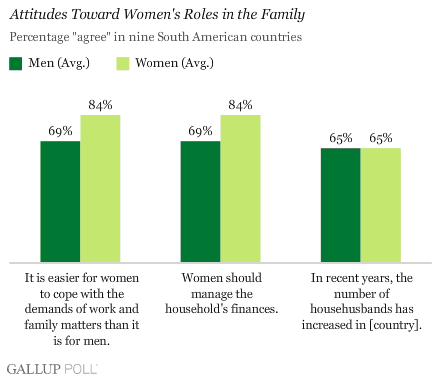WASHINGTON, D.C. -- The historic election of Argentina's president-elect Cristina Fernandez de Kirchner has reignited the discussion of gender roles in Latin America. In South America, residents appear accepting of women in positions of power. The broader question is whether this acceptance is largely confined to the public sphere or if it reflects a shift in underlying attitudes applicable to the private domain as well. The answer could affect the future of the region as deeply entrenched gender biases have long hurt economic growth and development in Latin America.
Recent Gallup Polls in South America suggest recent social trends -- such as dropping fertility rates and the growing presence of women in the workforce -- have fostered attitudes that no longer fit neatly into the conception of a male-dominated Latin American society. Data from nine South American countries reveal that on average, a majority of men (69%) and women (84%) agree that it is easier for women than men to juggle work and family demands. Almost identical percentages agree that women should manage the household's finances. And roughly two in three men (65%) and women (65%) in the nine countries agree that the number of househusbands in their countries has increased.

Women in the Workplace
Almost everywhere in Latin America, progress toward greater gender parity is evident in education. World Bank figures indicate that in several countries -- including Argentina, Brazil, and Colombia -- girls are enrolled in secondary school at higher rates than boys. A 2004 report from the Inter-American Development Bank noted that one potential factor in this difference is higher unemployment rates for teenage girls, making them more likely than boys to stay in school.
However, women's greater likelihood to remain unemployed suggests these gains in educational parity are often not capitalized on outside the home. Though it has narrowed in the past two decades, the gap between the proportion of men and the proportion of women in the workforce remains relatively wide. According to the most recent International Labour Organization statistics, the typical female-to-male ratio in the labor forces in the nine South American countries surveyed is 3-to-4 (by comparison, the corresponding ratio in the United States is about 9-to-10).
On the other hand, those women who do have jobs are no less likely than employed men in these nine countries to feel positive about their work. On average, 84% of employed men and 85% of employed women say they are satisfied with their jobs, while 85% of men and 88% of women say their jobs give them the opportunity to do what they do best every day. Perhaps most tellingly, given women's historical social status, an average of 78% of employed men and 80% of employed women say their opinions count at work.
Bottom Line
The progress of women in Latin America shouldn't be overstated. Strict gender roles still inhibit modernization in some areas, and problems such as domestic violence and gender wage gaps still exist. Nonetheless, these survey results suggest that the increased visibility of female leaders is a manifestation of growing gender parity.
Survey Methods
Results are based on face-to-face interviews with about 1,000 adults, aged 15 and older, in each of the nine countries conducted between June and October 2007. For results based on each national sample, one can say with 95% confidence that the maximum margin of sampling error is ±3 percentage points. In addition to sampling error, question wording and practical difficulties in conducting surveys can introduce error or bias into the findings of public opinion polls.
